|
Maxton Engineering are one of the world’s top motorcycle suspension specialists, and the perfect people to demystify the springy stuff.
Words and photos by: John Milbank
How many times have you heard the local pub pundit dishing out his ‘expert’ advice: “You want to stiffen that up with a bit more preload” or “My bike chatters as I push it hard into corners, so I run a heavier fork oil”? You know it’s cobblers, and you know how suspension works, but do you REALLY know how to interpret what your bike is doing, and what you can do about it? Do you REALLY know if the suspension on your machine is as good as it can be? I don’t mind admitting that, until I visited Maxton Engineering, I still didn’t REALLY know…
How suspension works
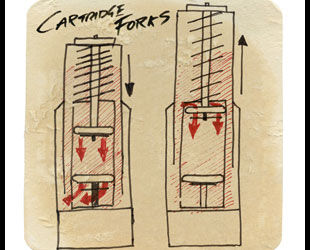 In the 60s and 70s, most bikes used a simple damper rod in the forks, with a basic piston moving through oil to control the return (rebound) of the front-end. As bikes and tyres improved, more precision was needed. Enter cartridge forks. These give separate control of the damping as the fork compresses and rebounds, by moving oil within a chamber (the cartridge). A piston on the end of the sprung fork rod displaces oil through a valve in the base of the cartridge under compression. On its return (rebound), the oil is governed by a valve built into the fork rod’s piston… See the beer-mat sketch for a simplified explanation. In the 60s and 70s, most bikes used a simple damper rod in the forks, with a basic piston moving through oil to control the return (rebound) of the front-end. As bikes and tyres improved, more precision was needed. Enter cartridge forks. These give separate control of the damping as the fork compresses and rebounds, by moving oil within a chamber (the cartridge). A piston on the end of the sprung fork rod displaces oil through a valve in the base of the cartridge under compression. On its return (rebound), the oil is governed by a valve built into the fork rod’s piston… See the beer-mat sketch for a simplified explanation.
During slow-speed damping (gentle movement of the bike’s suspension), a needle restricts the flow of oil through a hole in the centre of these valves, just like a pilot jet in a carburettor. In high-speed damping (over harsher bumps), a sprung stack of shims are pushed out of the way and the oil flows through carefully designed ports in the perimeter of the same valve.
The spring and the compression damping both work to support your bike – reduce one, and you can (to a point) balance it with an increase to the other, but then you have to consider the rebound damping that works against the spring when the suspension returns… It’s a bouncy, oily love-triangle.
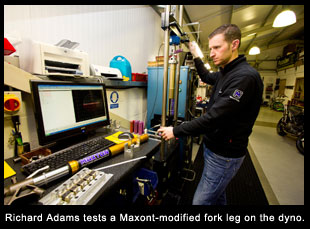 Your shock absorber is generally connected to the swingarm through a linkage (except on twin-shock bikes like the XJR) – which translates the travel of your rear wheel to the movement of the shock by a certain ratio: sometimes by as much as 3:1. There are also rising-rate and linear linkages to consider: A rising-rate (or progressive) linkage moves the shock by a greater ratio as the swingarm rises further. Your shock absorber is generally connected to the swingarm through a linkage (except on twin-shock bikes like the XJR) – which translates the travel of your rear wheel to the movement of the shock by a certain ratio: sometimes by as much as 3:1. There are also rising-rate and linear linkages to consider: A rising-rate (or progressive) linkage moves the shock by a greater ratio as the swingarm rises further.
On a smooth track, a progressive linkage helps the rear get firmer as the suspension is loaded, making it easier to get the back wheel to spin up, and drift controllably out of corners. At the Isle of Man TT, for instance, there are large bumps, and fast changes of direction, so linear suspension is best: If the rear shock ‘locks up’, that force has to go somewhere, so the weight is thrown to the front of the bike over bumps. Not good.
On road bikes, while a linear setup would generally be the best bet, you’ll tend to find progressive linkages (R1s and R6s being among the exceptions). Relatively cheap shocks are used on most of our machines, so the linkage is helping the shock to support the motorcycle, especially where pillions and luggage have to be taken into consideration.
How it affects your ride
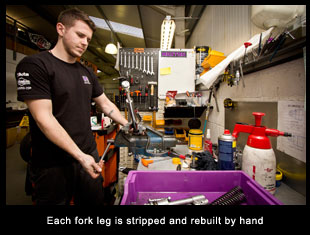 A common issue in a road-bike is a lack of support from the forks, making it dive under braking. This is caused either by a too-soft spring, or too little compression damping. Generally, it’s the springs that are too soft. Adding more compression damping works when you’re braking, but unlike a spring it won’t be able to move quickly enough when you’re in a corner, making the front wheel kick off small bumps. It’s often best to use a 10-15% stiffer spring, then fine-tune the compression damping for the perfect ride. A common issue in a road-bike is a lack of support from the forks, making it dive under braking. This is caused either by a too-soft spring, or too little compression damping. Generally, it’s the springs that are too soft. Adding more compression damping works when you’re braking, but unlike a spring it won’t be able to move quickly enough when you’re in a corner, making the front wheel kick off small bumps. It’s often best to use a 10-15% stiffer spring, then fine-tune the compression damping for the perfect ride.
Of course, this stiffer spring will be working against the rebound damping, and the bike can run wide as you accelerate out of a corner, because the forks are unloading too quickly. Another way to spot a lack of rebound damping is when going straight-on in a fast roundabout, turning quickly left, right and left again. The bike might enter okay, but as you come out of the first left it ‘fires’ up, making it harder to push into the right and left again.
At the rear, if the bike’s squatting under acceleration, you’ll need more support. Increasing compression damping can fix this, but as it’s slower to react than a spring, it’ll give you a harsher ride. Again, a stiffer spring means you’ll need a bit more rebound damping, but it’s less important than on the front, as too much rebound on the shock makes the bike ratchet down over bumps (known as jacking down).
Basically, you need rebound damping on the front to hold the bike in position during fast direction changes, but not too much on the rear, so the bike can keep the tyre in better contact with the road.
Contrary to what many believe, adjusting the preload on your bike just affects the ride height. This is measured as ‘static sag’, and is typically 10mm at the rear, and 25mm at the front. It’s what gives the bike a bit of slack before a wheel is lifted off the ground. We’ll show you how to check this in a future issue, but if in doubt, stick with the standard settings.
The best way to get a feel for what your bike does is to find a ten mile ‘circuit’ with a variety of surfaces and bends. Get used to how it reacts and you’ll have a better understanding of what’s going on.
New springs and settings then?
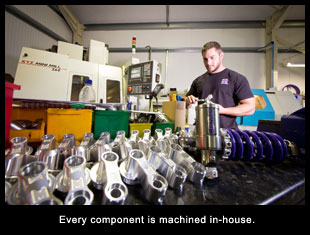 Suspension has improved a lot over the last few years, but more than ever, bikes are being designed to a price (we all want cheap bikes, right?). Manufacturers will often go to a suspension company with a very limited budget, and fit a set-up that reflects what they believe to be suitable for their notion of the world’s average rider, on their average roads. Suspension has improved a lot over the last few years, but more than ever, bikes are being designed to a price (we all want cheap bikes, right?). Manufacturers will often go to a suspension company with a very limited budget, and fit a set-up that reflects what they believe to be suitable for their notion of the world’s average rider, on their average roads.
As an example, let’s take my 2000 model Honda CBR600. This has cartridge forks, and is quite soft as standard, being under-damped and under-sprung. It’s a comfortable sports-tourer, designed for a variety of riders who might carry luggage and a pillion. If I fitted stronger fork springs, I’d have to increase the rebound damping, but the needle valves in these forks aren’t very effective, acting more as an on/off tap than giving true control. So, heavier oil then? This could help, but only with the low-speed damping: As the shim-stacks come into play over sharper bumps and mid corner, the weight of oil is irrelevant, so with a stiffer spring and thicker oil I’ll just have a bike that bounces about too quickly.
It’s the same story on many modern bikes, and even those with high-quality kit as standard are designed only to suit an average rider and road.
You might ask why ineffective adjusters are put on some bikes: Adjustability is of course a selling point, but it can also be a problem. It wouldn’t be hard for someone with limited knowledge to fiddle with their compression and rebound, only to make the bike worse. If enough people did this, rumour might spread that the bike’s a bad ride. It could be that it’s better for motorcycle manufacturers to give only a minimum of adjustment, and not allow an owner to take the bike out of a ‘window’ of optimum – but average – settings.
How to fix it
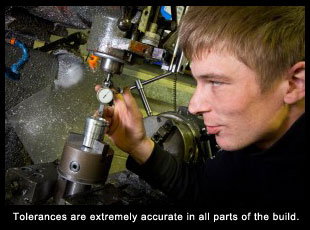 Maxton engineering make suspension to suit you, your bike, and your roads, and machine every part (except the springs) in their Maxton engineering make suspension to suit you, your bike, and your roads, and machine every part (except the springs) in their
Cheshire factory. Over the years, hundreds of TT racers have paired up with Maxton, and the company currently also supports 20 BSB teams.
It’s certainly not all about sports bikes or racing – the Triumph Explorer, for instance, is great on perfectly smooth roads, but Maxton have had a huge number of customers looking for help with the hard suspension on UK surfaces. Equally, many riders of tourers, nakeds and classics around the world have benefitted from having their suspension modified to perfectly suit them.
With most road-bikes having progressive shock linkage ratios (for the first 25mm of swingarm travel, the shock might move 12mm, whereas in the last 25mm, it can be as much as 16mm), the ride can get really harsh as the bike is loaded up. Maxton look at the weight of the rider, along with their riding style, to get the ideal setting – allowing the shock to work perfectly on any given bike.
Contact Maxton by phone or email and you won’t get a hard sell – what you will receive is a list of options, from springs and oil for your forks, to a complete rebuild or replacement cartridges. You’re also welcome to visit the factory, where they’re happy to help you look at all the options.
On my CBR, because the damping adjustment is so poor, it’d need new valves. Fortunately, the cartridges are re-buildable, so sending Maxton my forks would see them returned, ready to run, with new springs, valves and oil perfectly matched to my weight and riding-style, with full adjustability.
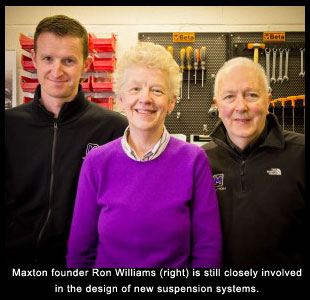 The Showa shock on my old Honda can be rebuilt, but parts aren’t available, and Maxton value their reputation too much to bodge a rebuild. If I wanted to improve the rear I’d opt for their RT10 unit. The Showa shock on my old Honda can be rebuilt, but parts aren’t available, and Maxton value their reputation too much to bodge a rebuild. If I wanted to improve the rear I’d opt for their RT10 unit.
Prices vary depending on what you need, but as a guide, to change the springs and oil in forks is £114, or the average revalve and respring is £438, including new seals and oil. An RT10 rear shock (designed for road or track use) is £498 for bikes like the VFR800, R1200GS etc, or £696 for a remote-reservoir version.
It’s not pocket-money, but keep in mind that the OE shock for a 2010 Fireblade is over £1200, and Maxton’s prices for bespoke equipment look much more reasonable.
Most of us ‘put up’ with our suspension, but only when you start to think about what your bike’s doing, and try a modified set-up, do you discover what you’re really capable of.
The history of Maxton
A family business, Maxton was founded by Ron Williams in 1971, working on his own building frames for Yamaha engines to race at the TT. Going on to design and manufacture his own magnesium wheels, then working for Honda Racing Corporation (HRC), Norton and the HRC Grand Prix team, Ron ended up using his knowledge and experience to create suspension for race bikes.
Ron’s stepson, Richard Adams, took over Research and Development in 2004, after already working at the company for nine years. Also taking care of the day-to-day running of the business, this leaves Ron free to concentrate on his passion: the design of suspension systems and shock absorbers. Call Maxton and you’ll most likely speak to Richard, or his mum, Mary.
Back
AARON CLARKE -BRANDS HATCH
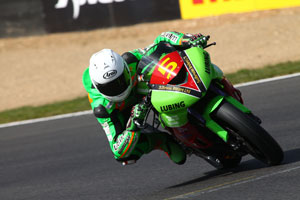 Despite a low grid position and suffering from arm pump Kirton racer Aaron Clarke completed his debut race in the 2014 National Superstock 600 championship in 26th place, well outside a points scoring position but at least a finish.
Qualifying didn't quite go the way that Aaron would have liked. The first session on Saturday began well but as the laps went by Aaron began to suffer from arm pump which caused him to slow and drop back to 36th place. Sunday's final qualifying was a non-event as although Aaron did put in a few laps the weather was against him as the rain made the track treacherous. There was nothing to be gained by staying out there as there was no way he could improve on the dry times he had set the day before so he decided to sit out the remainder of the session.
Starting from a 12th row grid position in 36th place Aaron got away to a good start to the 22 lap race. But the red flag brought the racing to an end due to a multiple bike crash on the first lap. Lining up on the grid for a second time and with the race having been reduced to 14 laps Aaron set off once again and began to make progress through the field.
He made his way through to 25th place but was forced back on the final lap and completed the race in 26th position.
Aaron said: "I am a bit disappointed but there again at least I did finish the race which has given me the confidence to build on the result next time out. It was always going to be a difficult year for me to move up from club racing to the ultra competitive Superstock 600 class and it’s going to be a huge learning curve for me this year. But with perseverance and determination I will improve.
"My lap times have improved immensely over the weekend which is encouraging, the bike ran smoothly so it’s just a matter of overcoming the arm pump. Its been a difficult weekend here at Brands Hatch as the weather was dreadful yesterday and of course there are very few passing places which doesn’t help."
Back
A positive first round with points gained!
The great British weather saw a mixed qualifying session for both Adam Jenkinson and Victor Cox, so it was down to race day to get a good start and grab some points!
Both riders felt qualifying could have gone better resulting in Adam qualifying 7th and Victor in 25th, due to missing the second qualifying session. We caught up with the team to get their thoughts about the race.
Adam Jenkinson ‘I got a good start, and I felt positive about the race, knowing we had the capability of a podium finish. Unfortunately due to a brake problem I was unable to make any good passes, the brake lever was coming back to the handle bar and I just couldn’t do anymore! It was frustrating more than anything as I knew we could have had a strong result. I enjoyed the race, and to take a 5th place with the brake problem I had, it felt like an achievement! I was just happy to take away some points to Oulton Park, which is my home round. We have learnt alot this weekend, and we’ll go away and make some adjustments to the bike before Oulton Park in 2 weeks. The team are working well, and I’m all fired up for round 2!’
Victor Cox ‘After qualifying in 25th, I knew I had to get a good start in order to get into the points. I just got my head down and focused on getting up the pack. We made a few adjustments to the bike before the race, and it was alot drier than previous days so that helped. I fort my way through to 11th, which I was pleased with after qualifying so far back. We’ve had a good first race weekend, and I’m looking forward to Oulton Park in 2 weeks. I like Oulton Park and won their last year, so hopefully we can take away some good points and get another win there!’
Steve Brogan, Team Manager ‘I am really pleased with both Adam and Victor this weekend. They have both shown great character and a ‘never give up’ attitude. Adam would have been on the podium if he didn’t have a brake problem, so to salvage a 5th from that was a fantastic result! For Victor to get into the points and come from 25th on the grid to 11th was also a great achievement. We will have a test at Oulton before the race weekend in 2 weeks in order to make some small adjustments to both bikes. I’d once again like to say a big thanks to our mechanics, Richard at Maxton Suspension, Chris at Direct CCTV, Nick at Philbin Glass Recycling, Kawasaki Uk and all our other sponsors!’
The Superstock 1000 race will be shown on Thursday 24th April on British Eurosport at 6pm.
Oulton Park Round 2 will be on bank holiday Monday 5th May, Live on British Eurosport from 12:30.
Back
Mixed Weekend for ILR Kawasaki at Brands Hatch
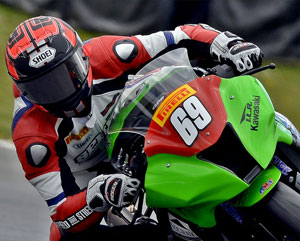
Danny Eslick finished eighth in his debut race for ILR Kawasaki in the first round of the Pirelli National Superstock 1000 Championship at Brands Hatch on Easter Monday.
With the exception of a recent track day with the team at the Kent circuit a few weeks ago Eslick had never been round Brands Hatch before, but it wasn't long before the Daytona 200 winner was into his stride on the Ninja ZX-10R.
Both he and his experienced team-mate Robbin Harms were well on the pace from the first practice session with Eslick finishing first qualifying in sixth place and Harms a fraction of a second behind in tenth.
Any attempts to climb up the grid were frustrated by the awful weather conditions that blighted the second session and so the grid positions were dictated by the previous day's session, placing Danny on the second row with Robbin heading Row 4.
The race was only two minutes old when an incident at Paddock Hill Bend brought the safety car out and ultimately the race was stopped.
A quick re-start was announced over a reduced 20 laps but again there was drama, this time on the opening lap and it concerned Harms who was taken out of the race by Jesse Trayler.
Eslick was now the team's only runner in the race and the American lapped consistently for the opening seven laps before settling into 8th position where he determinedly remained despite a race long challenge from Daniel Johnson, as well as Hudson Kennaugh in the closing stages.
So despite the disappointment of Robbin Harms' early exit from the race, the team nevertheless took consolation from Danny Eslick's strong showing.
Back
Farquhar marks Scarborough return with double podium
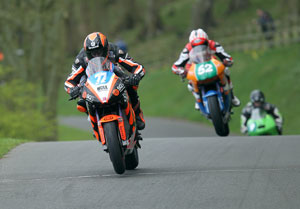 Ryan Farquhar marked his return to Oliver’s Mount, Scarborough on Sunday with a brace of podiums on the SGS International/KMR Kawasaki in the two Supertwin races. Competing at the Yorkshire venue for the first time since July 2012, and having his first real road race of the season, Farquhar took the runners-up spot behind Ivan Lintin in each of the two eight lap races.
The 2.43-mile woodland circuit saw good, dry weather throughout the day and although a strong wind developed as the day wore on conditions were ideal when the first 8-lap Supertwin race came under starters orders. Indeed, a perfect start saw Ryan grab the lead going into the first corner and he led the field round at the completion of the opening lap.
Second time around, Lintin found his way past Ryan and soon opened up a lead on his Tigcraft-framed Kawasaki, eventually taking a 2.3s win, and for the remainder of the race, Ryan had his hands full keeping James Cowton at bay. There was little to choose between the duo around the tree-lined circuit but, setting his fastest lap on the eighth and final lap, Ryan was able to keep Cowton behind him thus opening his account for the day with a strong second place.
The second race later in the day was almost a carbon copy of the first with Ryan again taking the lead going into Mere Hairpin, staying ahead of the pack for the opening lap. Lintin again moved to the front second time around with Ryan settling into second and Cowton third. On this occasion, the gaps between the three riders was similar and whilst Ryan couldn’t put the pressure on Lintin as he would have liked, he had a nice cushion over Cowton and duly took his second runner-up spot of the day to open his 2014 road racing season in solid fashion.
Speaking later, a satisfied Ryan said; “Things couldn't have gone any better this weekend and if someone had said on Sunday morning I'd walk away with two second places, I'd have snapped their hand off. I always knew Ivan was going to be the man to beat as he's got his Tigcraft-framed bike dialled in really well so I just wanted to try and be the first TT-spec bike to finish. He has a bit of an advantage on the brakes going into the corners and accelerating away from them but that's taking nothing away from him as he's riding really well and has really established himself now."
"Even if I'd have got a third and a fourth, I'd have been over the moon so to be on the pace like I was, with lap times as quick as what I've ever done, bodes really well. This year's focused around the TT and these early season meetings are all about getting back up to speed, getting race fit and getting all the signatures required for the Mountain Course licence so it's definitely been a case of 'job done' this weekend. We've a new engine-spec on its way which should give us more power so a big thank you to everyone that's chipped in to get us back on the grid this year and also to everyone who helped out this weekend. It was also great to see such a large crowd at Oliver's Mount, it's a great place and this can only help the circuit in the long-term."
Back
Dan Hegarty links up with ILR Kawasaki for 2014 Isle of Man TT
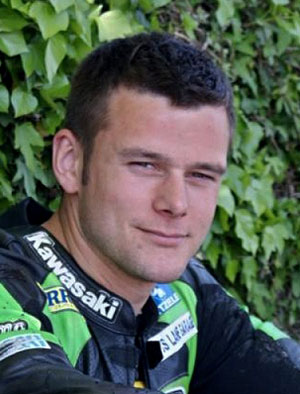
ILR Kawasaki are pleased to announce that Dan Hegarty will race for the team at the 2014 Isle of Man TT races.
Dan will be competing in the Superstock race on the ILR Kawasaki Ninja ZX-10R and will also be running his own privateer team in the Superbike and Supersport classes out of the ILR Kawasaki set-up during the fortnight.
The news also continues team manager Ian Lougher's long association with the famous event following his retirement from competitive racing last year.
26 year old Hegarty from Nottingham is very much gearing his 2014 season round the TT and is looking forward to his fourth year competing over the Mountain Course.
He was the fastest newcomer in the Superbike race at the 2011 TT with a lap of 118mph finishing 32nd, and he registered a Top 20 finish in the opening Supersport TT in 2012.
Last year he missed the Superbike TT with a brake problem before finishing 36th in the Blue Riband Senior race, setting a fastest lap of 122mph on what was very much a bike in the early stages of development.
'Hego' believes he has yet to show his true potential over the 37.75 miles circuit and he goes to this year's event fully intent on realising his personal ambitions of improved results and lap times and further justifying his growing reputation as one of the riders to watch.
Dan Hegarty:
''This is a literally my boyhood dreams coming true. I was first inspired to start road racing when I stood at Olivers Mount Hairpin watching Ian Lougher take on the big boys in the Gold Cup on his Honda 250, and Ian has been a secret hero of mine ever since then.
Here I am 10 years later with Ian for a mentor to take on the Mountain Course in my most serious campaign to date.''
ILR Kawasaki team manager Ian Lougher:
''It's a real pleasure to be involved with a young, enthusiastic and most of all intelligent rider like Dan for this year's TT races. It has always been my plan to try and pass on some of my knowledge to younger guys coming through on the roads, it would be such a shame for all that experience I have at the Isle of Man to go to waste. So I'm really looking forward to working from the other side of the fence with such a promising, dedicated rider like Dan Hegarty.''
Back
Double podium for Harrison and RC Express Racing at season opener
Dean Harrison and the RC Express Racing team got their 2014 road racing season underway on Sunday with a brace of podiums at Oliver’s Mount, Scarborough. With good, dry conditions at the Yorkshire circuit, the Bradford rider claimed strong second and third place finishes in the two Superbike races on board the team’s 1000cc ZX-10R Kawasaki.
The first 8-lap Superbike race saw Dean line up on the front row of the grid and he slotted into third place at the end of the opening 2.43-miles behind early leader Lee Johnston and Ivan Lintin. Overhauled by Guy Martin a lap later, but getting the better of Lintin, Dean remained in third place for the next five laps but on the sixth lap he managed to find a way by Johnston to move up to second.
Martin had opened up a substantial lead by then but Dean kept pushing for the final quarter of the race, setting his best lap seventh time around and he eventually crossed the line in second place, 4.1s behind Martin.
The dry, sunny conditions remained throughout the day but by the time the feature Ian Watson Trophy Superbike race came to the line, a strong wind was gusting around the woodland circuit making riding conditions more precarious.
A slightly sluggish start saw Dean back in fourth at the completion of the first lap and with Martin settling into an early lead, the Suzuki rider immediately began to open up a gap over the rest of the field. Subsequently, Dean found himself involved in a three-way tussle for second with Johnston and Lintin and as the race entered its final quarter it was down to a two-way shoot-out between Dean and Lintin.
There was little to choose between the two riders around the narrow course and with Lintin defending his lines into the sharp hairpin bends, finding a way through wasn’t an easy task. Dean made a final effort at Mountside Hairpin on the eighth and final lap but in the end had to settle for third thus making it two podiums from his two races.
Dean Harrison: “You always want to win but for our first meeting of the year, I’m pleased with how today went. The Superbike’s an absolute missile in a straight line but we’ve a new electronics package on board this year and whilst I’m getting used to it all the time, I’m not quite up to speed with it yet. I’m learning all the time but Scarborough’s obviously a circuit where you’re up and down the gearbox all the time and a couple of times the bike jumped out of third gear, which was just enough to hold me back from getting onto the rear wheel of Guy.”
“The lap times were good though and I was only a couple of tenths off Guy and these early season meetings are perfect for ironing out little issues like this so when we get to the International races next month, the North West 200 and TT, everything will be dialled in how we want it to be. Each time I go out on the bike, I’m happier and more comfortable and we know what areas to work on so, all in all, it’s been a good day”
Back
|